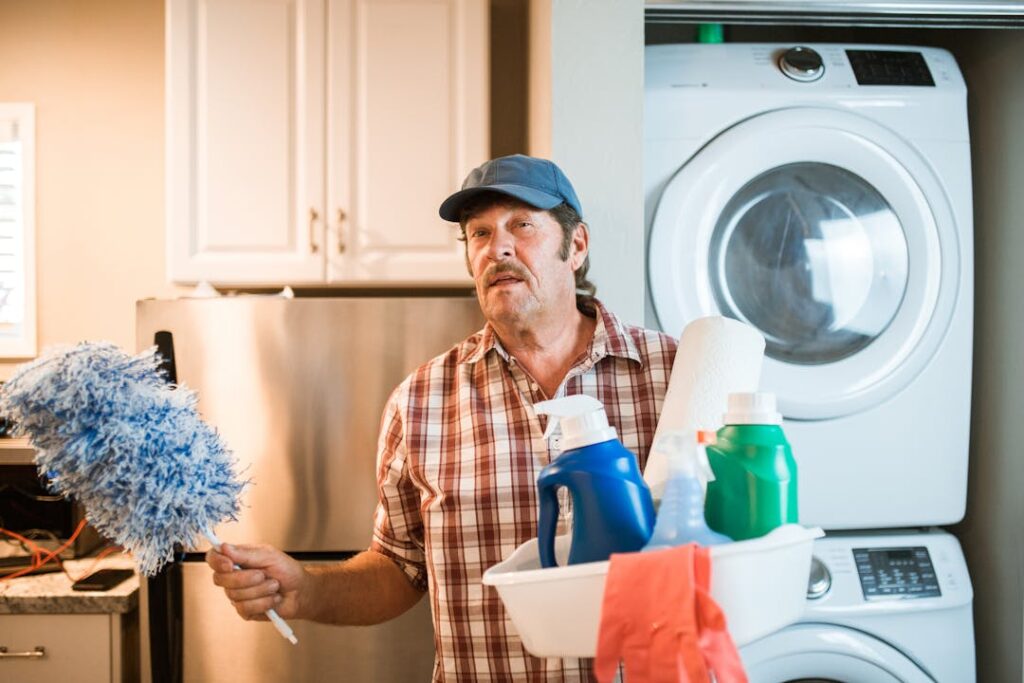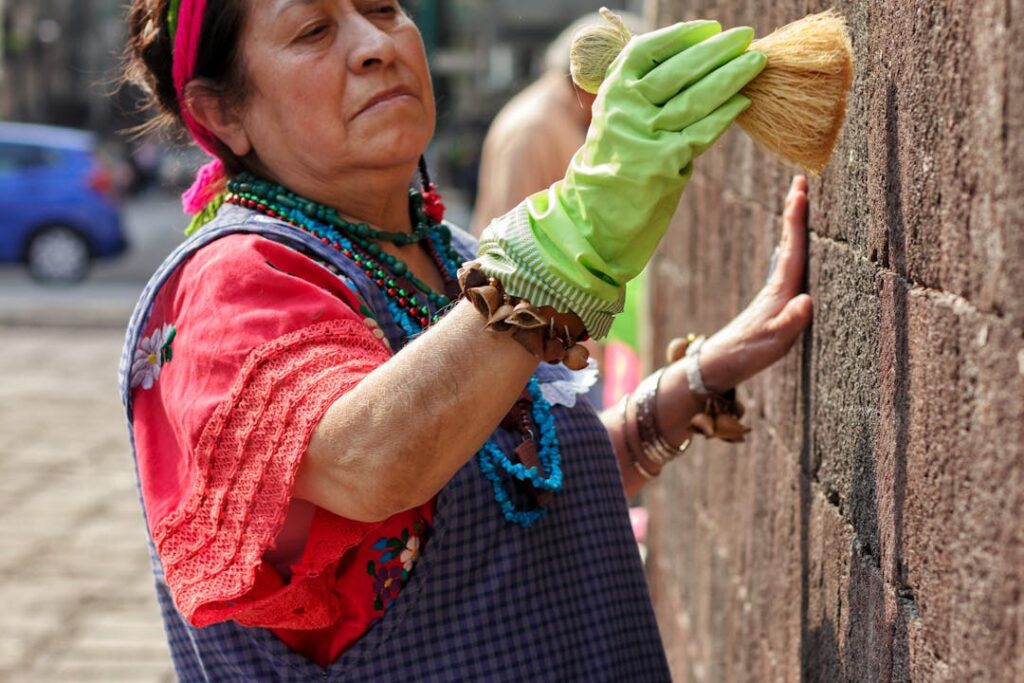Keeping your walls spotlessly clean doesn’t have to be a daunting task.
Rather, with a few simple tips and tricks, you can keep your walls looking fresh and pristine.
Here’s something we can both agree on…
Walls are not just background elements in our homes; they contribute significantly to the overall ambiance and cleanliness.
Therefore, having clean walls not only enhances aesthetics but also promotes a healthier living environment.
Whether you’re dealing with stains, scuff marks, or dirt accumulation, this article will provide effective solutions to maintain the cleanliness of your walls.
Here then are five simple steps to ensure your walls stay pristine.
The Importance of Clean Walls
Your room is attractive, decor and all.
When people walk into the room, they are mesmerized.
But wait a minute. There is something off.
The walls. They are not only clogged with dirt but traces of cobwebs can be seen. Da! That puts off your visitors; the decor forgotten.
On the other hand, if you have clean walls, that’s a plus. They look appealing and still prevent the buildup of dirt, dust, and allergens.
Further, regular wall maintenance can extend their lifespan and reduce the need for frequent repainting.
Back to your guests; they’ll find a sweet, clean haven to relax.
Step 1: Gather Your Cleaning Supplies

For effective wall cleaning, you first need to assemble cleaning tools and equipment
Some of the necessary supplies include:
- Mild detergent or wall cleaner. An all-purpose cleaner is a good alternative
- Soft sponges or microfiber cloths
- Bucket of warm water
- Dust pans/soft broom to collect debris
- Ladder or step stool (if needed)
It is also necessary to have proper PPE when cleaning. Prepare yourself with:
- Safety shoes
- Gloves and dust mask
- Dustcoats or overalls
- Protect your eyes with safety goggles
- You’ll also need a safety helmet
Now that you have your equipment in place, you need to know your type of wall. Is it wall-papered? If painted, is the paint water- or oil-based? Note that the latter withstands more regular cleaning than the former.
Ok, we can now go to the next step.
Step 2: Dust and Remove Cobwebs
When you start cleaning, pay special attention to areas likely to get dirt and dust faster than others.
These include door knobs, switches, wall sockets, behind doors, areas with picture frames, and walls next to furniture (when placed too close to walls).
To begin, start by dusting the walls from top to bottom using a soft cloth or duster. Then remove cobwebs from corners and ceiling edges.
Equally, address the areas with stains and marks promptly and determine if they need a coat of fresh paint. Baking soda can also do wonders for cleaning smudges.
Step 3: Wash the Walls
Prepare a solution of mild detergent or wall cleaner in warm water. Then dip a sponge or cloth into the solution, wring out excess water, and gently wipe the walls in small sections.
Avoid soaking the walls to prevent damage. Another danger of washing the walls with lots of water is exposing them to mold and mildew.
Afterward, rinse the area for a cleaner finish.
Note: avoid using harsh chemicals.
Step 4: Address Stubborn Stains
When you need to remove other stains like crayon marks, drawings, and other writing stains, e.g., ballpoint pens, markers, etc., apply a paste made from baking soda and water or use a specialised cleaner.
It will also work well for stains like grease. Apply gently and rinse immediately.
The use of wallpapers is sometimes necessary. It effectively conceals stubborn stains while still giving the room a fresh breath of life.
Step 5: Finish with a Protective Coat
At length, you may need to protect your walls with fresh paint. After cleaning, consider applying a protective coat or sealer to the walls. This helps repel stains and makes future cleaning easier.
You can also go a step further and use wallpaper instead.
And if cleaning seems daunting, maybe it’s time you consider hiring professional cleaners for deep cleaning.
Benefits of Keeping Walls Clean

Here are some of the benefits that come with keeping your walls clean regularly:
- Improved Indoor Air Quality: Clean walls reduce dust and allergens, improving air quality
- Enhanced Aesthetics: Clean walls contribute to a visually appealing interior. Remember our visitors in the introduction?
- Longer Lifespan: Regular maintenance can extend the lifespan of your walls and paint
In essence, you only need to clean the walls now and then.
Tips for Maintaining Clean Walls
DIY wall cleaning solutions
- Spot clean stains immediately to prevent them from setting
- Use caution when using cleaning products to avoid damaging paint or wallpaper
- Schedule regular wall maintenance to prevent buildup
- Clear off smoke in the house, especially in the kitchen
- Deter children from writing on walls. Provide them with writing boards instead
Common Mistakes to Avoid
When cleaning the walls, avoid these common mistakes
- Use of abrasive cleaners that can damage paint or wallpaper.
- Scrubbing walls vigorously, can remove paint or leave streaks.
- Don’t forget to rinse walls thoroughly after cleaning to prevent residue buildup.
Wrapping Up
Maintaining clean walls is a simple yet effective way to enhance your home’s cleanliness and elegance. Don’t wait too long to give it that tender care.
By following these five steps and adopting good maintenance habits, you can enjoy clean and pristine walls for years. And with it the assurance that your other decor will stand out in a clean environment.
How do you clean your walls? If you need assistance, just holler.
Our brand takes pride in offering practical and easy-to-implement solutions for all your cleaning needs.
Your Questions on Wall Cleaning
How often should I clean my walls?
It’s recommended to clean your walls at least once every six months. However, high-traffic areas or areas prone to splashes and stains may require more frequent cleaning.
Can I use vinegar to clean walls?
Yes, vinegar can be an effective and natural cleaner for walls. Combine equal parts vinegar and water to make a mild cleaning solution. To be sure it won’t harm the paint or finish, test it first on a small, discrete area.
How do you best remove mold from walls?
To remove mold from walls, use a mixture of water and detergent or a specialized mold cleaner. Gently scrub the affected area with a sponge or brush, and rinse thoroughly thereafter. Remember to wear protective gear when tackling mold.
Is it necessary to repaint walls after cleaning?
Regular cleaning is sufficient unless the paint is damaged or worn out significantly. Proper cleaning and maintenance can help preserve the appearance of your walls without the need for frequent repainting.
How can I prevent fingerprints and smudges on painted walls?
To prevent fingerprints and smudges on painted walls, don’t touch them with dirty hands. Also, consider using washable or matte-finish paint that is easier to clean.
[…] at it, you will also need to do a deep cleaning of your house, paying special attention to walls and floors, particularly hardwood. You don’t want your maintenance to leave other places of your […]